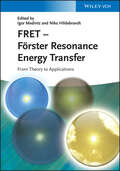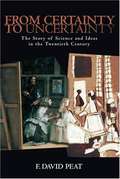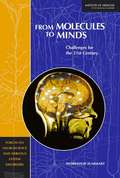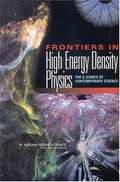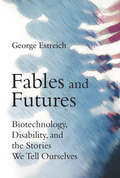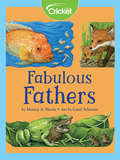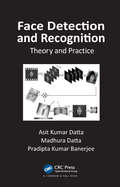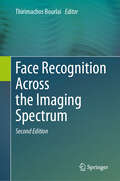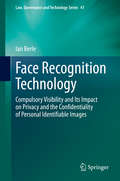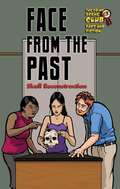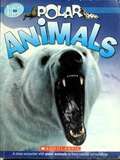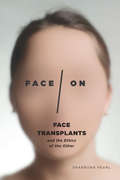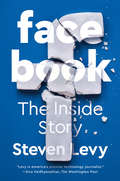- Table View
- List View
FRET - Förster Resonance Energy Transfer
by Niko Hildebrandt Igor MedintzMeeting the need for an up-to-date and detailed primer on all aspects of the topic, this ready reference reflects the incredible expansion in the application of FRET and its derivative techniques over the past decade, especially in the biological sciences. This wide diversity is equally mirrored in the range of expert contributors.The book itself is clearly subdivided into four major sections. The first provides some background, theory, and key concepts, while the second section focuses on some common FRET techniques and applications, such as in vitro sensing and diagnostics, the determination of protein, peptide and other biological structures, as well as cellular biosensing with genetically encoded fluorescent indicators. The third section looks at recent developments, beginning with the use of fluorescent proteins, followed by a review of FRET usage with semiconductor quantum dots, along with an overview of multistep FRET. The text concludes with a detailed and greatly updated series of supporting tables on FRET pairs and Förster distances, together with some outlook and perspectives on FRET. Written for both the FRET novice and for the seasoned user, this is a must-have resourcefor office and laboratory shelves.
FROM CERTAINTY TO UNCERTAINTY: The Story of Science and Ideas in the Twentieth Century
by F. David PeatEarly theorists believed that in science lay the promise of certainty. Built on a foundation of fact and constructed with objective and trustworthy tools, science produced knowledge. But science has also shown us that this knowledge will always be fundamentally incomplete and that a true understanding of the world is ultimately beyond our grasp. In this thoughtful and compelling book, physicist F. David Peat examines the basic philosophic difference between the certainty that characterized the thinking of humankind through the nineteenth century and contrasts it with the startling fall of certainty in the twentieth. The nineteenth century was marked by a boundless optimism and confidence in the power of progress and technology. Science and philosophy were on firm ground. Newtonian physics showed that the universe was a gigantic clockwork mechanism that functioned according to rigid laws—that its course could be predicted with total confidence far into the future. Indeed, in 1900, the President of the Royal Society in Britain went so far as to proclaim that everything of importance had already been discovered by science. But it was not long before the seeds of a scientific revolution began to take root. Quantum Theory and the General Theory of Relativity exploded the clockwork universe, proving beyond a shadow of a doubt that our knowledge was, at best, incomplete—and would probably remain that way forever. There were places in the universe, such as black holes, from which no information at all could ever be obtained. Chaos Theory also demonstrated our inherent limits to knowing, predicting, and controlling the world around us and showed the way that chaos can often be found at the heart of natural and social systems. Although we may not always recognize it, this new world view has had a profound effect not only on science, but on art, literature, philosophy, and societal relations. The twenty-first century now begins with a humble acceptance of uncertainty. From Certainty to Uncertainty traces the rise and fall of the deterministic universe and shows the evolving influences that such disparate disciplines now have on one another. Drawing on the lessons we can learn from history, Peat also speculates on how we will manage our lives into the future.
FROM MOLECULES TO MINDS: Challenges for the 21st Century
by Institute of Medicine of the National AcademiesNeuroscience has made phenomenal advances over the past 50 years and the pace of discovery continues to accelerate. On June 25, 2008, the Institute of Medicine (IOM) Forum on Neuroscience and Nervous System Disorders hosted more than 70 of the leading neuroscientists in the world, for a workshop titled "From Molecules to Minds: Challenges for the 21st Century." The objective of the workshop was to explore a set of common goals or "Grand Challenges" posed by participants that could inspire and rally both the scientific community and the public to consider the possibilities for neuroscience in the 21st century. The progress of the past in combination with new tools and techniques, such as neuroimaging and molecular biology, has positioned neuroscience on the cusp of even greater transformational progress in our understanding of the brain and how its inner workings result in mental activity. This workshop summary highlights the important issues and challenges facing the field of neuroscience as presented to those in attendance at the workshop, as well as the subsequent discussion that resulted. As a result, three overarching Grand Challenges emerged: How does the brain work and produce mental activity? How does physical activity in the brain give rise to thought, emotion, and behavior? How does the interplay of biology and experience shape our brains and make us who we are today? How do we keep our brains healthy? How do we protect, restore, or enhance the functioning of our brains as we age?
FRONTIERS IN High Energy Density Physics: THE X-GAMES OF CONTEMPORARY SCIENCE
by Committee on High Energy Density Plasma PhysicsRecent scientific and technical advances have made it possible to create matter in the laboratory under conditions relevant to astrophysical systems such as supernovae and black holes. These advances will also benefit inertial confinement fusion research and the nation's nuclear weapons program. The report describes the major research facilities on which such high energy density conditions can be achieved and lists a number of key scientific questions about high energy density physics that can be addressed by this research. Several recommendations are presented that would facilitate the development of a comprehensive strategy for realizing these research opportunities.
FRONTIERS IN High Energy Density Physics: THE X-GAMES OF CONTEMPORARY SCIENCE
by National Research Council of the National AcademiesRecent scientific and technical advances have made it possible to create matter in the laboratory under conditions relevant to astrophysical systems such as supernovae and black holes. These advances will also benefit inertial confinement fusion research and the nation’s nuclear weapon’s program. The report describes the major research facilities on which such high energy density conditions can be achieved and lists a number of key scientific questions about high energy density physics that can be addressed by this research. Several recommendations are presented that would facilitate the development of a comprehensive strategy for realizing these research opportunities.
FTIR Microspectroscopy: Selected Emerging Applications
by Noureddine AbidiFourier Transform Infrared microspectroscopy (FTIR) was first developed by William Coblentz in 1905 for analytical purposes. It has been established as a powerful analytical method to analyze a wide range of materials. The most convenient way to analyze the molecular structure was to prepare KBr pellets with small amount of chemical species. Currently, the development of the Universal Attenuated Total Reflectance (UATR) allows the use of ZnSe-Diamond crystal to acquire FTIR spectra directly from the sample with no special preparation. These traditional FTIR analyses have been made with devices capable of performing single measurements, thus, providing a single IR spectrum of the sample. Recent major technological development in FTIR instrumentation was development of microscopes and imaging systems. These devices are now capable of imaging larger sample area, providing not only spectroscopic information but also spatial distributional information. In addition, the development of Focal Point Array (FPA) has made FTIR imaging an emerging area of chemical imaging research. The aim of this book is to summarize in a single document the research work that is being performed using UATR and IR imaging in selected emerging applications in plant materials and biological samples. This book provides the readers new knowledge, updates information, emerging applications, and understanding of the potential use of FTIR Microspectroscopy.
Faba Bean: Chemistry, Properties and Functionality
by Sanju Bala Dhull Sneh Punia BangarFaba bean is a species of flowering plant in the Fabaceae family and the fourth most widely grown winter season legume after pea, chickpea, and lentil. The nutritional profile of faba beans is excellent as they contain an adequate quantity of proteins, carbohydrates, vitamins, minerals and various polyphenols. Faba bean seeds are a rich source of carbohydrates and starch. Because of higher amylose content than cereal starches, legume starches provide distinctive properties such as high gelation temperature, fast retro-gradation, high resistant starch and gel elasticity to food systems. Faba bean has been a beneficial source of protein in food products worldwide for centuries and continues to be highly produced and consumed to this day. Faba bean Chemistry, Properties and Functionality studies the global status and production of faba bean food products plus their agronomy, nutritional value and potential medicinal applications. The agrarian conditions are studied in full, as are postharvest practices. The chemical makeup of faba bean is a major focus, especially in relation to nutrient composition and quality. Chapters in this text focus on anti-nutritional attributes, antioxidants and bioactive compounds plus the effects of processing, storage and cooking on their nutritional value. Starch and its modification, structure, properties and industrial applications are covered, as is protein, genetic improvement and functional product formulation. The text also looks at the future perspectives of this valuable plant and food source. To date, no reference works have exclusively covered faba bean. This book provides a much-needed single source reference point for researchers looking to gain knowledge on this important plant and its use in high protein, health-beneficial food products.
Fables and Futures: Biotechnology, Disability, and the Stories We Tell Ourselves (The\mit Press Ser.)
by George EstreichHow new biomedical technologies—from prenatal testing to gene-editing techniques—require us to imagine who counts as human and what it means to belong.From next-generation prenatal tests, to virtual children, to the genome-editing tool CRISPR-Cas9, new biotechnologies grant us unprecedented power to predict and shape future people. That power implies a question about belonging: which people, which variations, will we welcome? How will we square new biotech advances with the real but fragile gains for people with disabilities—especially when their voices are all but absent from the conversation?This book explores that conversation, the troubled territory where biotechnology and disability meet. In it, George Estreich—an award-winning poet and memoirist, and the father of a young woman with Down syndrome—delves into popular representations of cutting-edge biotech: websites advertising next-generation prenatal tests, feature articles on “three-parent IVF,” a scientist's memoir of constructing a semisynthetic cell, and more. As Estreich shows, each new application of biotechnology is accompanied by a persuasive story, one that minimizes downsides and promises enormous benefits. In this story, people with disabilities are both invisible and essential: a key promise of new technologies is that disability will be repaired or prevented.In chapters that blend personal narrative and scholarship, Estreich restores disability to our narratives of technology. He also considers broader themes: the place of people with disabilities in a world built for the able; the echoes of eugenic history in the genomic present; and the equation of intellect and human value. Examining the stories we tell ourselves, the fables already creating our futures, Estreich argues that, given biotech that can select and shape who we are, we need to imagine, as broadly as possible, what it means to belong.
Fabre, Poet of Science
by Bernard Miall Georges Victor LegrosFabre studied insects, taught about insects, and wrote prolifically about insects. His writing is beautiful and descriptive. He is author of "The Life of the Spider."
Fabric Filtration for Combustion Sources: Fundamentals and Basic Technology
by R.P. DonovanThis book focuses on the most important applications of fabric filtration: environmental protection, particulate control from combustion sources. It summarises the types of fibers and their properties and gives an overview of textile processing.
Fabric and Fiber Inventions: Sew, Knit, Print, and Electrify Your Own Designs to Wear, Use, and Play With
by Kathy CeceriIn this book you'll create your own fabric inventions as you learn to make wearables, playthings, and decorative items using textile arts--both old and new. Easy projects using will get you started knitting, adding color to your wardrobe with silkscreen and batik, and transforming old clothing into useful items. Then you'll find out how soft circuits can give your creations personality with light, sound, and motion. Fabric and Fiber Inventions will show you how to turn everyday materials into unique designs everybody will love.
Fabrication and Physical Properties of Novel Two-dimensional Crystal Materials Beyond Graphene: Germanene, Hafnene and PtSe2 (Springer Theses)
by Linfei LiThis thesis reports on essential experimental work in the field of novel two-dimensional (2D) atomic crystals beyond graphene. It especially describes three new 2D crystal materials, namely germanene, hafnene, and monolayer PtSe2 fabricated experimentally for the first time, using an ultra-high vacuum molecular beam epitaxy (UHV-MBE) system.Multiple characterization techniques, including scanning tunneling microscope (STM), low energy electron diffraction (LEED), scanning transmission electron microscope (STEM), and angle-resolved photoemission spectroscopy (ARPES), combined with theoretical studies reveal the materials’ atomic and electronic structures, which allows the author to further investigate their physical properties and potential applications. In addition, a new epitaxial growth method for transition metal dichalcogenides involving direct selenization of metal supports is developed. These studies represent a significant step forward in expanding the family of 2D crystal materials and exploring their application potentials in future nanotechnology and related areas.
Fabrication and Properties of High-Performance 122-Type Iron-Based Superconducting Wires and Tapes (Springer Theses)
by Chao YaoThis book addresses new ways to optimize the fabrication process and performance of iron-based superconducting wires and tapes based on the powder-in-tube (PIT) method. Further, it systemically analyzes and enhances the current-carrying ability of wire and tape conductors with regard to chemical addition, mechanical deformation, and heat treatment. The microstructure of the superconducting cores is studied by means of the magneto-optical imaging technique, high-resolution transmission electron microscopy, and flux pinning analysis. This book will benefits all students, researchers, and technical personnel who work in superconducting materials, applied superconductivity, and the power industry.
Fabrication of Heat-Resistant and Plastic-Formable Silicon Nitride
by Xin Xu Toshiyuki NishimuraIn this book, improvements in the heat resistance of silicon nitride (Si3N4) ceramics using grain boundary control and in plasticity at high temperatures using grain size control in order to reduce the cost of shaping Si3N4 are described. The heat resistance of Si3N4 is improved by mixing a slight amount of sintering additive as an impurity into the original material powder. The author presents his findings on the high heat resistance of Si3N4. The author also develops a new fabrication method for Si3N4 nano-ceramics that produces high plastic formability. The method developed offers two improved points in grinding and sintering processes. The author found that the plastic formability of Si3N4 nanoceramics is dependent on load stress; the results of his research are detailed in this book.
Fabrication of Metal–Organic Framework Derived Nanomaterials and Their Electrochemical Applications (Springer Theses)
by Wei XiaThis thesis systematically introduces readers to a new metal-organic framework approach to fabricating nanostructured materials for electrochemical applications. Based on the metal-organic framework (MOF) approach, it also demonstrates the latest ideas on how to create optimal MOF and MOF-derived nanomaterials for electrochemical reactions under controlled conditions. The thesis offers a valuable resource for researchers who want to understand electrochemical reactions at nanoscale and optimize materials from rational design to achieve enhanced electrochemical performance. It also serves as a useful reference guide to fundamental research on advanced electrochemical energy storage materials and the synthesis of nanostructured materials.
Fabrication of Micro/Nano Structures via Precision Machining: Modelling, Processing and Evaluation
by Bin Xu Guoqing Zhang Yanjun Lu Suet ToThis book introduces the cutting-edge technology of micro/nano structure fabrication from precision machining, electrical discharge machining (EDM) and precision grinding and injection molding, the contents of the presented book includes but not limited to the machining process, cutting tool preparation, tool path generation, and surface evaluation. This book provides a variety of feasible fabrication methods and advanced manufacturing techniques for the precision fabrication of micro/nano-structures, especially for complex micro/nano-structures. Since the book focuses on the micro/nano-structure fabrication methods including hieratical micro/nano-structures, graduate students, engineering technicians, and researchers in related areas will benefit from this book; also, someone in related application fields such as biomedicine, communication, optics may be the potential readers of this book.
Fabulous Fathers
by Monica A. HarrisFathers come in all shapes and sizes. In the animal kingdom, fathers have some fascinating (and strange!) ways of helping their young. Some animal dads protect their babies. Some provide food. Some teach survival skills.
Face Detection and Recognition: Theory and Practice
by Asit Kumar Datta Madhura Datta Pradipta Kumar BanerjeeFace detection and recognition are the nonintrusive biometrics of choice in many security applications. Examples of their use include border control, driver's license issuance, law enforcement investigations, and physical access control.Face Detection and Recognition: Theory and Practice elaborates on and explains the theory and practice of face de
Face Recognition Across the Imaging Spectrum
by Thirimachos BourlaiEmbark on a journey through the recent groundbreaking developments in face recognition (FR) systems with our second edition. Initially designed for controlled conditions, FR systems have evolved to conquer real-world challenges, adapting to low-light scenarios and extended distances. Our book delves into the transformation brought about by advancements in imaging sensors and cost-effective infrared (IR) cameras, exploring intensified near-infrared (NIR), shortwave IR (SWIR), middle-wave IR (MWIR), and long-wave IR (LWIR) imagery. This edition caters to the burgeoning interest in FR technologies, aligning with recent strides in computer vision, pattern recognition, and biometric analysis. Tailored for biometrics researchers, practitioners, and students, it addresses the critical need for FR algorithms in operational environments. Our book encompasses three comprehensive sections: (a) Face Recognition and Biometric Systems: Dive into topics such as face profile, facial attractiveness, periocular and binocular recognition, and quality training for face-based examinations. (b) Biometric System Security and Attacks: Explore adversarial attacks, domain transformers, demographic fairness, ocular pathologies, and distance-based classification of biometric images. (c) Biometric Image Synthesis and Technology Enhancements:Uncover the secrets of face image synthesis, thermal band head pose estimation, facial image analysis in forensic examination, and optimal computer monitor configurations. With 13 meticulously crafted chapters, this edition provides updated insights, experimental findings, and a roadmap for the future. Each chapter delivers a rich exploration of its specific topic, weaving together background information, literature reviews, methodologies, experiments, and concluding with challenges and future directions. Elevate your understanding of evolving face recognition technologies – the future awaits!
Face Recognition Technology: Compulsory Visibility and Its Impact on Privacy and the Confidentiality of Personal Identifiable Images (Law, Governance and Technology Series #41)
by Ian BerleThis book examines how face recognition technology is affecting privacy and confidentiality in an era of enhanced surveillance. Further, it offers a new approach to the complex issues of privacy and confidentiality, by drawing on Joseph K in Kafka’s disturbing novel The Trial, and on Isaiah Berlin’s notion of liberty and freedom. Taking into consideration rights and wrongs, protection from harm associated with compulsory visibility, and the need for effective data protection law, the author promotes ethical practices by reinterpreting privacy as a property right. To protect this right, the author advocates the licensing of personal identifiable images where appropriate.The book reviews American, UK and European case law concerning privacy and confidentiality, the effect each case has had on the developing jurisprudence, and the ethical issues involved. As such, it offers a valuable resource for students of ethico-legal fields, professionals specialising in image rights law, policy-makers, and liberty advocates and activists.
Face from the Past: Skull Reconstruction (The Crime Scene Club, Case #6)
by Kenneth McintoshA guide to reconstructing skulls. Each tale is followed by a guide to its vocabulary, technology, and background.
Face to Face: Polar Animals
by Sally MorganA close encounter with polar animals in their natural surroundings.
Face/On: Face Transplants and the Ethics of the Other
by Sharrona PearlAre our identities attached to our faces? If so, what happens when the face connected to the self is gone forever—or replaced? In Face/On, Sharrona Pearl investigates the stakes for changing the face–and the changing stakes for the face—in both contemporary society and the sciences. The first comprehensive cultural study of face transplant surgery, Face/On reveals our true relationships to faces and facelessness, explains the significance we place on facial manipulation, and decodes how we understand loss, reconstruction, and transplantation of the face. To achieve this, Pearl draws on a vast array of sources: bioethical and medical reports, newspaper and television coverage, performances by pop culture icons, hospital records, personal interviews, films, and military files. She argues that we are on the cusp of a new ethics, in an opportune moment for reframing essentialist ideas about appearance in favor of a more expansive form of interpersonal interaction. Accessibly written and respectfully illustrated, Face/On offers a new perspective on face transplant surgery as a way to consider the self and its representation as constantly present and evolving. Highly interdisciplinary, this study will appeal to anyone wishing to know more about critical interventions into recent medicine, makeover culture, and the beauty industry.
Facebook: The Inside Story
by Steven LevyHe has had unprecedented access to Mark Zuckerberg and Sheryl Sandberg for three years. And now renowned tech writer Steven Levy delivers the definitive history of one of America&’s most powerful and controversial companies: Facebook.In his sophomore year of college, Mark Zuckerberg created a simple website to serve as a campus social network. The site caught on like wildfire, and soon students nationwide were on Facebook. Today, Facebook is nearly unrecognizable from Zuckerberg&’s first, modest iteration. It has grown into a tech giant, the largest social media platform and one of the most gargantuan companies in the world, with a valuation of more than $576 billion and almost 3 billion users, including those on its fully owned subsidiaries, Instagram and WhatsApp. There is no denying the power and omnipresence of Facebook in American daily life. And in light of recent controversies surrounding election-influencing &“fake news&” accounts, the handling of its users&’ personal data, and growing discontent with the actions of its founder and CEO, never has the company been more central to the national conversation. Based on hundreds of interviews inside and outside the company, Levy&’s sweeping narrative digs deep into the whole story of the company that has changed the world and reaped the consequences.
Facebook®: How Mark Zuckerberg Connected More Than a Billion Friends
by Celicia ScottToday, Facebook is one of the most-used websites on the Internet, visited by millions of users each day and home to more than 500 million accounts. Many people use Facebook to share pictures, news, and ideas with friends--but they may not know the true story behind Facebook's massive success. Facebook began as the idea of one college student: Mark Zuckerberg. Discover how Mark founded one of the most successful social networking sites on the Internet while he was still in school. Learn how he first got Facebook growing, and how he keeps millions of people logging in day after day. Find out more about the man behind Facebook--and learn what's next for his company.
